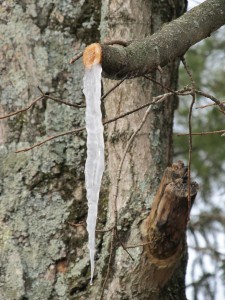Winter can be a cruel period for trees. Day-night temperatures may wildly fluctuate and drying winds tend to injure tender buds. Maples (Acer spp.), flowering dogwoods (Cornus florida), birches (Betula spp.), yellowwoods (Cladrastis kentukea), walnuts (Juglans spp.) and elms (Ulmus spp.) are “bleeders”. The sap pressure inside branches is highest during the winter months.
If any tree jeopardizes a house, property, utility lines, and human safety, it should be pruned no matter the time of year. The bleeding sap phenomena is over-rated. Winter-pruned bleeder trees will not die. If it humanly bothers you, prune these “bleeder” species in the summer when sap pressure is lowest.
Leaky sap may drip on pedestrians, cars, and walkways resulting in stains on trunk bark and sidewalks. Puddles on walkways may freeze and create slippery pavement.
Bleeding or sap loss will eventually stop on its own. Quickly, the pruning wound cuts have internally sealed off and the healing process started.
Spraying paint (wound dressing) does not help. Many times the sap flow is so plentiful as to wash the wound paint off. You may want to irrigate the tree during dry spells to speed wound healing.
If you’re seeking advice about pruning large shade trees, consult a certified arborist first. The International Society of Arboriculture (ISA) website should list one or more in your area.


 Posted in
Posted in 
